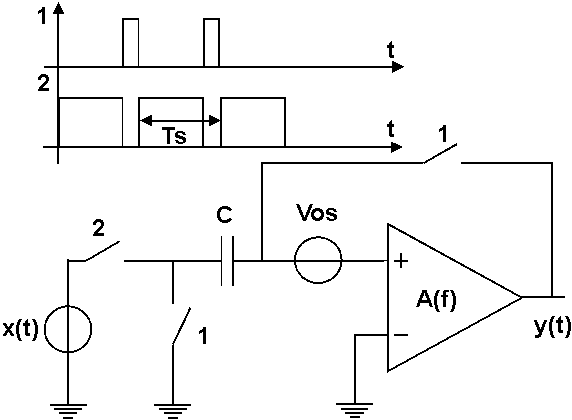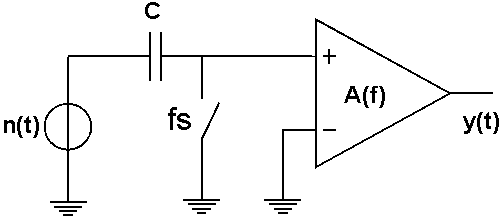|
CHAPTER 5
Chopping:
a technique for noise and offset reduction
5.2. Ways to reduce offset and 1/f noise
Offset and 1/f noise
are setting constraints on the obtainable accuracy and dynamic range in the case of CMOS amplifiers. There are
several ways to reduce offset and low frequency noise based on sampling or
modulation. The autozero technique and correlated double sampling
techniques are methods of reducing 1/f noise and offset based on sampling.
Due to white noise undersampling, the decrease of 1/f noise and offset is
paid by the increase of baseband white noise. In this section the two
methods are considered and their advantages and disadvantages are
discussed.
5.2.1. The autozero technique
The autozero
technique [2], [3], [4] reduces the offset and low frequency noise based
on sampling methods. This method has been extensively used in the past for
offset reduction in comparators and amplifiers [4]. Most of the nowadays
A/D converters with offset cancellation make use of auto-zeroed
comparators. Fig.5.1 illustrates the principle of an autozero amplifier.
In the phase 1 of the clock, the sampling phase, the offset and the
flicker noise of the amplifier configured as a buffer is sampled on the
capacitor C.
|

|
|
Fig.5.1: The autozero
technique |
The output y(t) is actually the offset voltage
VOS as long as the open loop gain of the amplifier
AOL is large:
 (5.1)
(5.1)
In the second phase of the clock, the amplification
phase, the input signal x(t) is sampled and amplified. The offset and 1/f
noise is removed from the output by subtracting the value sampled on the
capacitor from its actual output:
 (5.2)
(5.2)
The equivalent input offset is reduced by a factor equal
to the amplifier open loop gain. The reduction of 1/f noise is based on
the high correlation between the 1/f noise samples. The charge injected
from the switch produces residual offset which is not cancelled by the
autozero mechanism. To show the autozero effect consider a stationary
random process n(t) which can be white noise or flicker noise generated by
the amplifier A from fig.5.1. For simplicity the amplifier is assumed to
have an infinite bandwidth, unity gain A=1 and the input signal is x(t)=0.
The equivalent circuit for the noise sampling is shown in fig.5.2.
Assuming the switch ideal, the voltage on the capacitor C is an ideal
sample and hold signal. If kTs are sampling time instants, h(t)
the hold function, the voltage on the capacitor C is:

(5.3)
At the output of the amplifier we have a signal y(t)
:

(5.4)
|

|
|
Fig.5.2: Noise sampling in autozero
amplifiers |
Given the sample and hold of the noise and/or offset on
the capacitor C the output spectrum is found to
be:
 (5.5)
(5.5)
The output noise spectrum is a sequence of spectra
shifted at multiples of sampling frequency Ts. The transfer
function for every harmonic Hk(f) has a value of:
 (5.6)
(5.6)
The transfer function for k=0 has a zero at the origin
and acts like a differentiator. Therefore, any DC component of the random
process n(t) is cancelled out. That is why this technique is called
autozero. Fig.5.3 shows the transfer functions for k=0 and k¹ 0. The power spectral density of the output noise is
found from (5.5):

(5.7)
If the random process n(t) is white noise the second term
from (5.7) introduces foldover components in the baseband. The first term
takes care for 1/f noise and offset reduction. The simple switched current
memory cell from Chapter 3 has also autozero properties and therefore
flicker noise is reduced. In conclusion, autozero amplifiers will reduce
the offset and 1/f noise by using sampling techniques at the expense of
increasing the white noise in the baseband.
5.2.2. Correlated double sampling
Correlated double sampling (CDS) is another
technique for offset and noise reduction [5], [6], [7], [8]. This method
has been used in charge coupled devices CCD. The main difference between
autozeroing and CDS consists in the way the signal is
|

|
|
Fig.5.3: Noise transfer functions
|
delivered to the output. In CDS methods, there are two
sampling times. A sampling time for noise only and a second sampling time
for noise and signal with opposite sign. In the CDS case the output is a
sampled and hold signal whereas for autozeroing, the output is a
continuous time output. CDS relies upon the same correlation between 1/f
adjacent samples. This method has also the disadvantage of aliasing white
noise in the
baseband. |